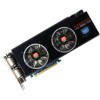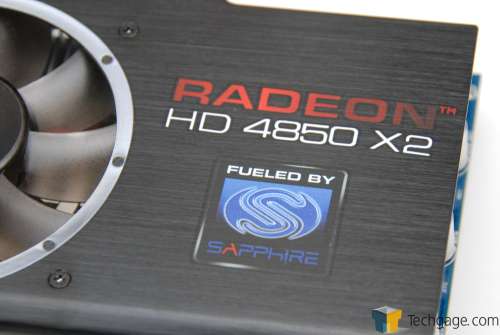- Qualcomm Launches Snapdragon 4 Gen 2 Mobile Platform
- AMD Launches Ryzen PRO 7000 Series Mobile & Desktop Platform
- Intel Launches Sleek Single-Slot Arc Pro A60 Workstation Graphics Card
- NVIDIA Announces Latest Ada Lovelace Additions: GeForce RTX 4060 Ti & RTX 4060
- Maxon Redshift With AMD Radeon GPU Rendering Support Now Available
Sapphire Radeon HD 4850 X2 2GB

If you game at ultra-high resolutions and want to know where the best bang for the buck can be found in graphics cards, look no further than Sapphire’s dual-GPU HD 4850 X2. At $300, it’s priced-right and offers incredible performance regardless of whether you prefer high anti-aliasing settings or resolutions.
Page 8 – Power Consumption, Final Thoughts
In the age where anyone can appreciate good power efficiency, it’s almost upsetting to see how much wattage any graphics card manages to pull from our walls. Even the lowest-end models don’t seem too impressive when compared to the power efficiency of a CPU, but that’s how it is, at least right now. It’s interesting to see how different GPUs compare in this regard, as some might perform better than others, but use less power, like we normally see with a shift to a smaller process node.
To help see what kind of wattage a given GPU eats on average, we use a Kill-A-Watt that’s plugged into a power bar that’s in turn plugged into one of the wall sockets, with the test system plugged directly into that. The monitor and other components are plugged into the other socket and is not connected to the Kill-A-Watt. For our system specifications, please refer to our methodology page.
Like our temperature testing, the computer is boot up and left idle for ten minutes, at which point the current wattage reading is recorded. To test for full load wattage, 3DMark Vantage is again loaded up and run at the “Extreme” setting. The space flight test is used here, with the result being recorded during a specific sequence during that run where it seems to stress the GPU the most.

It might be the slower clocks, or the GDDR3, but the power draw seen with Sapphire’s card is far less than the HD 4870 X2. These results help make the HD 4850 X2 look even better, as it’s close to just as fast as the bigger card in some tests, but the power draw is far easier to stomach.
GPU Temperatures
Regardless of whether or not you plan to overclock, having reasonable system temperatures is always welcomed. Not only will your machine be more reliable with cooler temps, it will likewise not add any unneeded heat to the room you are in (unless it happens to be wintertime and you keep the windows open, then it might be a good thing).
To test a GPU for idle and load temps, we do a couple things. First, with the test system turned off for at least a period of ten minutes, we measure the room temperature using a Type-K thermometer sensitive of up to 0.1°F. The result from this is placed beside the GPUs name in the graph below. Since we don’t test in a temperature-controlled environment, the room temp can vary by a few degrees, which is why we include the information here.
Once the room temp is captured, the test system is booted up and left idle for ten minutes, at which point GPU-Z is loaded up to grab the current GPU Core temperature. Then, a full run of 3DMark Vantage is run to help warm the card up, followed by another run of the same benchmark using the Extreme mode (1920×1200). Once the test is completed, we refer to the GPU-Z log file to find the maximum temperature hit. Please note that this is not an average. Even if the highest point was only hit once, it’s what we keep as a result.

Sapphire’s special cooler proved worth the effort, as seen here. Despite being a dual-GPU card, it ranks low in our graph, and saw temps just a little bit higher than a 9600 GT… that’s incredible. The best part is that the card was generally quite quiet as well. Although I didn’t take a sound meter to it, I can honestly say it was quieter than our reference HD 4870, even at full load.
Final Thoughts
I didn’t know what to expect when diving into testing this card, but it goes without saying that I’m quite impressed. For a $300 offering, it scales well in performance when compared to slightly lesser-expensive cards, such as the GTX 260/216. For the extra $30 – $50, you get a card that works much better with games at very high resolutions, or with copious amounts of anti-aliasing. If it came down to getting insane performance while keeping things as cheap as possible, the GTX 260/216 is still a great card, and for the most part, it’s probably a better choice for most people.
As with all of the current high-end cards, the HD 4850 X2 excels at the highest-resolution available, 2560×1600. If that’s the resolution you play at, this card is the card to buy. It has the best value, and given its dual-GPU nature, it will allow better performance over any single-GPU card currently out there in most cases. The one exception might be the GTX 280 in some tests, but that is likely to be a rare scenario.
In addition to the fair price, this card features a cooler that’s not exactly pleasing to the eyes, at least to me, but it’s light and very, very effective. Not to mention quiet. In addition, compared to the HD 4870 X2, it has a far more modest power drain. Overall, there are few downsides, and as a result, it would make a fantastic addition to your gaming PC if you are looking to spend $300 and have the capability to run very-high resolutions. If you run anything lower than 1920×1200, this card is extreme overkill. That can even be said about 1920×1200, but at least there, good AA settings could be used to take better advantage of the power available.
- Pros
- Extremely powerful, in some cases it comes close to the HD 4870 X2.
- Great cooler design, keeps temperatures low.
- Much lower power draw than the HD 4870 X2.
- At $300, it’s priced right.
- Cons
- The 4 DVI ports could be considered a downside, or an upside.
Discuss this article in our forums!
Have a comment you wish to make on this article? Recommendations? Criticism? Feel free to head over to our related thread and put your words to our virtual paper! There is no requirement to register in order to respond to these threads, but it sure doesn’t hurt!

Sapphire Radeon HD 4850 X2 2GB
Support our efforts! With ad revenue at an all-time low for written websites, we're relying more than ever on reader support to help us continue putting so much effort into this type of content. You can support us by becoming a Patron, or by using our Amazon shopping affiliate links listed through our articles. Thanks for your support!






